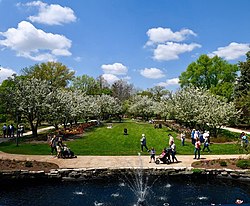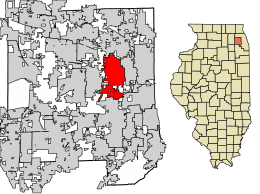|
Lombard, Illinois
Lombard is a village in DuPage County, Illinois, United States, and a suburb of Chicago. The population was 44,476 at the 2020 census. History Originally part of Potawatomi Native American landscape, the Lombard area was first settled by Americans of European descent in the 1830s. Lombard shares its early history with Glen Ellyn. Brothers Ralph and Morgan Babcock settled in a grove of trees along the DuPage River. In what was known as Babcock's Grove,[4] Lombard developed to the east and Glen Ellyn to the west. In 1837, Babcock's Grove was connected to Chicago by a stagecoach line which stopped at Stacy's Tavern at Geneva and St. Charles Roads. Fertile land, the DuPage River, and plentiful timber drew farmers to the area. Sheldon and Harriet Peck moved from Onondaga, New York, to this area in 1837 to farm 80 acres (320,000 m2) of land. In addition, Peck was an artist and primitive portrait painter who traveled to clients across northeastern Illinois. The Peck house also served as the area's first school and has been restored by the Lombard Historical Society.[5] In 2011, the Peck House was inducted into the National Park Service's Network to Freedom[6]—a list of verified Underground Railroad locations.[7] The 1848 arrival of the Galena and Chicago Union Railroad provided local farmers and merchants rail access to Chicago, and commercial buildings soon sprang up around the train station. Lombard was officially incorporated in 1869, named after Chicago banker and real estate developer Josia Lewis Lombard.[4] Women's rightsOn April 6, 1891, Ellen A. Martin led a group of women to the voting place at the general store. She demanded that the three male election judges allow the women to vote. The judges were so surprised that one of them had a "spasm," one leaned against the wall for support, and the other fell backwards into a barrel of flour.[8] They acquiesced to Ellen, but fundamentally did not want to let the women vote, so a county judge was asked to decide. He agreed that the women were right. Ellen Martin then became the first woman in Illinois to vote, and one of the first in the entire U.S. In 1916 Illinois women could vote in national elections, but the 19th Amendment (the Women's Suffrage Amendment) was not passed until 1920.[9] In 2008, Lombard declared April 6 to be "Ellen Martin Day" in commemoration of Ms. Martin's historic victory for women's suffrage.[10] Little Orphan Annie HouseWilliam LeRoy built a home in the Italianate style on Lombard's Main Street in 1881. LeRoy specialized in making artificial limbs for civil war veterans and lived in this house until 1900.[11] The house would eventually become the home of Harold Gray's parents and the studio of Harold Gray, the originator of Little Orphan Annie cartoon strip. Harold Gray used the home's study to work on the Annie cartoons, and some features of the house are drawn into some of his cartoons, such as the grand staircase and the outer deck. Gray lived at 215 S. Stewart Ave in Lombard at this time.[12] Later, he remarried and moved to the east coast. Harold Gray was a charter member of Lombard Masonic Lodge #1098, A.F. & A.M. in 1923. [citation needed] The Lilac VillageIn 1927, the estate of Colonel William Plum, a local resident, was bequeathed to the village. The Plum property included his home, which became the site of the original Helen M. Plum Memorial Library (decommissioned in 2023), and a large garden containing 200 varieties of lilac bushes. This garden became a public park, Lilacia Park. CultureSince 1930, Lombard has hosted an annual Lilac Festival and parade in May.[13] "Lilac Time in Lombard," is a 16-day festival ending in mid-May. It starts with the Lilac Queen coronation and her court. Many lilac themed events take place, including a formal ball, concerts, wine and beer tasting in the park, a Mothers' Day Brunch, an arts and crafts fair, and tours of the park. The grand finale is Lombard's Lilac Festival Parade.[14] The first Lilac Princess in 1930 was Adeline Fleege.[15] There is a farmers market held in downtown Lombard once a week from May to October every year. [16] There is a food cooperative slated to open sometime in 2024 in town. [17] EducationLombard's high schools (9-12) belong to Glenbard Township High School District 87.[18] They are shared with the neighboring town of Glen Ellyn, thus the creation of the portmanteau word "Glenbard". Lombard's elementary and middle schools (K-8) belong to Lombard School District 44[19] or DuPage School District 45.[20]
Village governmentThe Village of Lombard is a non-home rule community. It has a council–manager form of government. Each elective office is held for a four-year term.[21]
GeographyLombard is located at 41°52′34″N 88°0′54″W / 41.87611°N 88.01500°W (41.875979, -88.015060).[22] According to the 2021 census gazetteer files, Lombard has a total area of 10.41 square miles (26.96 km2), of which 10.22 square miles (26.47 km2) (or 98.21%) is land and 0.19 square miles (0.49 km2) (or 1.79%) is water.[23] Demographics
 As of the 2020 census[25] there were 44,476 people, 17,030 households, and 10,914 families residing in the village. The population density was 4,274.07 inhabitants per square mile (1,650.23/km2). There were 19,150 housing units at an average density of 1,840.28 per square mile (710.54/km2). The racial makeup of the village was 70.83% White, 4.62% African American, 0.35% Native American, 13.15% Asian, 0.01% Pacific Islander, 3.82% from other races, and 7.21% from two or more races. Hispanic or Latino of any race were 10.17% of the population. There were 17,030 households, out of which 28.6% had children under the age of 18 living with them, 51.20% were married couples living together, 9.82% had a female householder with no husband present, and 35.91% were non-families. 29.47% of all households were made up of individuals, and 11.30% had someone living alone who was 65 years of age or older. The average household size was 3.23 and the average family size was 2.54. The village's age distribution consisted of 20.4% under the age of 18, 9.0% from 18 to 24, 29% from 25 to 44, 25.8% from 45 to 64, and 15.7% who were 65 years of age or older. The median age was 37.7 years. For every 100 females, there were 93.0 males. For every 100 females age 18 and over, there were 91.7 males. The median income for a household in the village was $86,167, and the median income for a family was $100,420. Males had a median income of $58,398 versus $40,411 for females. The per capita income for the village was $41,154. About 3.5% of families and 5.6% of the population were below the poverty line, including 4.5% of those under age 18 and 5.9% of those age 65 or over.
EconomyAccording to Lombard's 2020 Comprehensive Annual Financial Report,[29] the top employers in the city are:
Transportation Lombard is served by Metra's Union Pacific West Line, which runs from the Ogilvie Transportation Center out to Elburn, Illinois over the old Chicago and Northwestern Railway trackage. Lombard's also served by I-88 / Illinois 110 and I-355 as well as Illinois Routes 38, 53, 56, and 64. Formerly, it was also served by trains of the Chicago Aurora and Elgin Railroad (with commuter stops at Stewart Ave, Main St, Brewster Ave and Westmore/Meyers Road) and the Chicago Great Western Railway. These former railroads have been preserved as multiple use recreational trails (Illinois Prairie Path and Great Western Trail). Pace provides bus service on multiple routes connecting Lombard to Naperville, Cicero, and other destinations. The Yorktown Center serves as a hub for bus routes in the area.[30] Notable people
See alsoReferences
External linksWikivoyage has a travel guide for Lombard. Wikimedia Commons has media related to Lombard, Illinois. |
||||||||||||||||||||||||||||||||||||||||||||||||||||||||||||||||||||||||||||||||||||||||||||||||||||||||||||||||||||||||||||||||||||||||||||||||||||||||||||||||||||||||||||||||||||||||||||||||||||||||||||||||||||||||||||||||||||||||||||||||||





